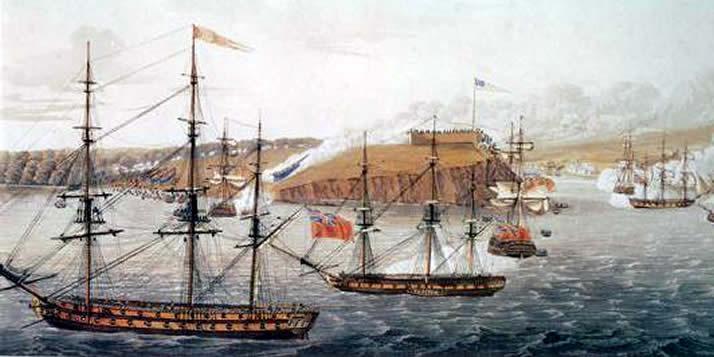Remembering the War of 1812

The War of 1812 is better recalled by Canadians than by Americans, says Calvin professor of history Will Katerberg.
This year marks the 200th anniversary of the War of 1812, one of whose epic battles inspired the United States national anthem. Although war—which featured the U.S. invasion of Ontario and the retaliatory Canadian sack of Washington D.C.— ended in a stalemate, the conflict could be considered something of a victory for Canada, said Calvin history professor Will Katerberg: the last land battle to take place within its own borders.
“British North America, now Canada, was able to repulse the United States from taking its territory,” he said. Today, he added, the War of 1812 is better remembered in that country than in the U.S.: “Though the war included some notable victories for the U.S., its results were ambiguous. And ambiguous outcomes are harder to remember as national myth and heritage.”
At the time of 1812’s outbreak, the United States had developed a growing trade with France, a country then engaged in the Napoleonic Wars with Great Britain. The War of 1812 officially began on June 18, 1812, when the United States House of Representatives signed a declaration of War against Great Britain, a country from which it had achieved independence from just 25 years earlier. The conflict lasted 32 months.
Northern expansion
The acquisition of land for a young and growing nation was perhaps the biggest motive behind the U. S. declaring war on Great Britain. “The United States saw more frontier land to the north in British North America,” said Calvin history professor Will Katerberg, who is currently co-leading a summer seminar on the Calvin campus entitled: American Frontiers in Global Perspective. “There were some who envisioned a United States that stretched north all the way to the arctic. Some American expansionists saw a frontier expanding to the north as well as to the west.”
Much of this frontier land was located in present-day Ontario. “British Upper Canada was made up of North American settlers, some of which were dedicated loyalists to the British crown, but many of whom came later, in the 1790s and early 1800s … looking for frontier land. These migrants sometimes are referred to as the ‘late loyalist,’” Katerberg said. “Loyalists from the 1780s also include native peoples, notably Iroquois, and slaves fleeing southern masters and following British promises of freedom.”
Several battles in the Great Lakes region ensued. The United States invaded and burned down present-day Toronto (then known as York) but the United States armed forces were repulsed. “The borders between United States and British North America were not as solid as we think today. They were easy to cross,” said Katerberg who holds dual citizenship in both the United States and Canada.
When the United States was repulsed from what is now Canada, the “mythology of the loyalists was produced,” Katerberg said: “They were loyal to king and country and felt a great accomplishment because of it. The more complicated history of the loyalists, and their mixed motives, was forgotten and people with American ties were looked on with suspicion by those who viewed their loyalist roots as pure and British.”
Winners and losers
The War of 1812 did confirm the independence of the United States and what also would become Canada said Katerberg. “In the end, no one really got what they wanted or got only pieces of what they wanted,” said Katerberg. “It did confirm that British North American would be independent of the United States, and it also confirmed that the United States would continue to be independent of Great Britain and gave it a distinct place on the world stage.”
One group that didn’t gain from the War of 1812 was a large coalition of Native American tribes led by the Shawnee tribe leader Tecumseh. Tecumseh and his coalition fought on the side of Great Britain, hoping for more independence and rights within the United States. When, in 1813, Tecumseh was killed in the Battle of the Thames near what is now known as Chatham, Ontario, the coalition fell apart.
The result said Katerberg was that “Native American nations east of the Mississippi lost any type of diplomatic and military influence when the war concluded.”
One lasting result of the war has been a 200-year old peace between the United States, Canada and Great Britain. Since the War of 1812, Britain, an independent Canada, and the United States have solved their disputes through diplomacy. They have also become closer trading partners and integrated the military defense of North America.
Born in the United States but brought up in Canada as the son of Christian Reformed Church pastor, Katerberg has always been appreciative of that part of the 1812’s legacy: “The peaceful border for 200 years between Canada and the United States is sometimes held up as an international example,” he said. “In the late 19th and 20th centuries, Canada even began to think of itself as a lynchpin between strengthened relations between the United States and Great Britain. That isn’t to say that there aren’t tensions from time-to-time between the U.S. and Canada, but the relationship between the two countries is positive. I think that’s one of the enduring, if unintended, outcomes of the aftermath of the War of 1812.”






